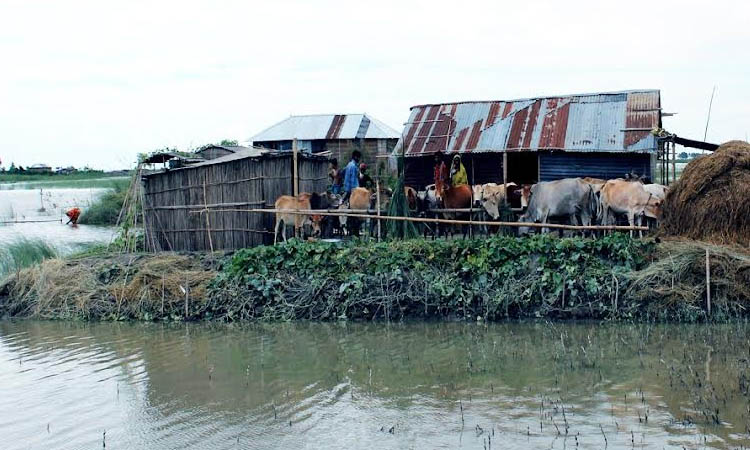News Flash

By Md Mamun Islam
RANGPUR, Aug 29, 2025 (BSS) - Many char people in ten districts of the Brahmaputra basin have adapted to the adverse effects of climate change and floods by constructing houses on raised plinths, helping them maintain normal livelihoods.
Experts have suggested replicating the success achieved a few years ago in char areas of Kurigram, Bogura, Gaibandha, Sirajganj, Jamalpur, Lalmonirhat, Nilphamari, Rangpur, Pabna, and Tangail to help other char communities cope with seasonal floods in the future.
Dr Syed Samsuzzaman, chairman of the North Bengal Institute of Development Studies (NIDS) and an agriculturist and researcher, said many char people benefiting from the Chars Livelihood Programme (CLP) have achieved self-reliance through income-generating activities (IGAs) despite difficult conditions.
The transformation of char communities from extreme poverty began with the 12-year (2004-2016) CLP, a joint initiative of government and non-government organizations.
The programme was funded by UK aid through the Department for International Development (DFID), the Australian Government through the Australian Agency for International Development (AusAID), and the Government of Bangladesh.
"Under the comprehensive programmes, hundreds of poor char families have improved their livelihoods, adapting to seasonal floods, river erosion, and generational poverty amid climate change," he said.
Calling the CLP one of the most effective projects for climate adaptation, Dr Samsuzzaman said it has become a blessing for char people living on riverine islands in the ten northern riverside districts of the basin.
After raising the plinths of beneficiary families' houses, various grants, assets, training, and other assistance were provided to make them self-reliant. Families were engaged in various IGAs under the joint supervision of government and NGOs.
"The raised plinths help char people escape floods and protect their properties and livestock. They also improve sanitation, provide access to safe drinking water, and allow families to continue IGAs even after the CLP ended," he added.
Md Mamunur Rashid, a PhD Fellow in the Department of Agricultural Extension at Dinajpur Haji Mohammad Danesh University of Science and Technology, said the successful implementation of the CLP through GO-NGO collaboration became a blessing for char people.
"The CLP not only assisted char people in adapting to the adverse effects of climate change, floods, and erosion, but also helped them overcome extreme poverty and improve socio-economic conditions, living standards, health, and hygiene," he said.
Md Mamunur Rashid, also an environmental expert, said adaptation to climate change has enabled char people to cultivate various crops on riverine char areas, including raised plinths, along with income-generating activities (IGAs), to maintain normal livelihoods.
"Adjusting to the adverse impacts of climate change, char people sow crop seeds at the beginning of the dry season on char lands, following the appearance of shoals with massive alluvial deposits during floods, to achieve excellent crop yields," he said.
Dr Md Abu Sayem, Deputy Director of the Burirhat Horticulture Center under the Department of Agricultural Extension in Rangpur, said char people cultivate crops on vast tracts of char lands every dry season.
"After adapting to the impacts of climate change, many char people successfully cultivate various crops, including vegetables and fruits, on their raised plinths throughout the year, even during floods," he said.
He added that hundreds of char households have achieved self-reliance through farming various crops and IGAs on char lands and their small homesteads on raised plinths, improving their living standards and reducing poverty.
The experts have advised the government to pursue programs like the CLP. This will help char people living in lower riverine areas protect themselves from seasonal floods, erosion, and other adverse effects of climate change and lead a normal life.
Talking to BSS, Nur Islam, Anwara Khatun, Parul Begum, Aklima Khatun, and Anwar Hossain of different char villages on the Teesta riverbeds in Rangpur described how they take refuge on their raised plinths during the rainy season.
Kajoli Begum, Lal Banu, and Sahera Begum of Ghughumari Char, Halima Begum of Char Krishnapur in Kurigram, and Rahela Khatun and Kulsum Begum of Purbo Char Gunai village in Rangpur called plinth-raising their savior during floods.
"We have adapted to climate change so that we can keep our property, essential goods, and livestock safe and help our neighbours take shelter on our raised plinth during floods. We cultivate various crops on char land and raised plinths," said Kulsum Begum.